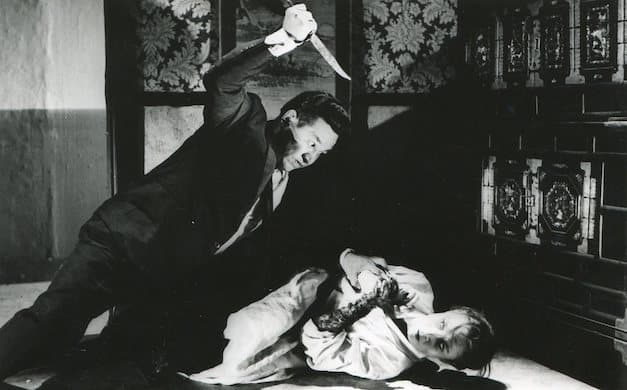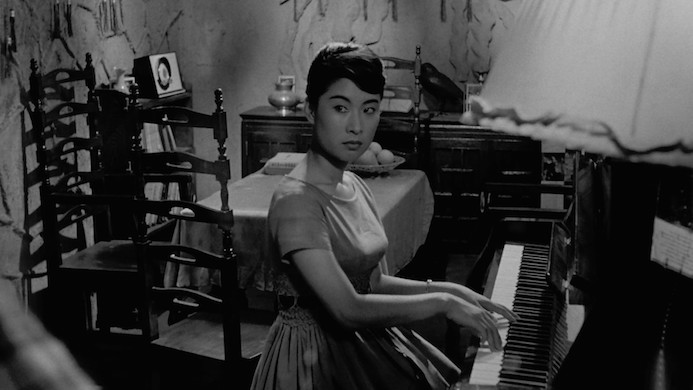‘Korean Cinema’s First Golden Decade’ May Have Been a More Apt Title
A cogent argument could be made that in addition to the 1960s, two-dozen films from which will be shown at Lincoln Center, we are currently living through a renaissance of Korean filmmaking.

The avant-garde has a lot to answer for, particularly Surrealism and Dada. As much as they may have liberated artists from the presumed burdens of rationalism, these movements also encouraged confusion and fostered estrangement among audiences. Standards can be restrictive, sure, but they also provide guidelines against which artists and viewers alike can navigate. Without standards, we are, to a significant extent, left befuddled.
Those who have seen “A Bloodthirsty Killer” (1965), a film included in “Korean Cinema’s Golden Decade: The 1960s,” an overview of two-dozen pictures being presented by Film at Lincoln Center, will likely know well what I’m talking about.
“A Bloodthirsty Killer” lies far afield from heady fare like “Un Chien Andalou” (1929) or “Meshes of the Afternoon” (1943), being closer kin to midnight movie staples like “The Black Cat” (1934) and “Carnival of Souls” (1962). Yet it does prompt questions about intent, meaning, and, in the end, artistic fact. I mean, how purposeful a mess is “A Bloodthirsty Killer”? Although there’s a strained attempt at establishing narrative logic toward the end of this tale of otherworldly revenge, the rest of it seems to have been made up on the fly. Experimental masterwork or unholy hodgepodge: In this case, it’s a distinction almost too fine to moot.
Is “A Bloodthirsty Killer” evidence of “Korea’s premier film renaissance”? The folks at Lincoln Center are on surer footing when touting eclecticism and innovation, but, then, there’s more to “Golden Decade” than one lone monster movie.
Actually, make that three monster movies: “The Great Monster Yonggary” and “Space Monster Wangmagwi” (both 1967) are also on the schedule. The two pictures are riffs on “Godzilla” that employ the time-honored tradition of “suitmation” — that is to say, actors stomping around in rubber outfits. Like any cinematic subculture, kaiju has its core of true believers and they will likely emit a collective gasp of amazement knowing that Lincoln Center will be screening the only surviving 35mm print of “Yonggary.”
Forget the 1960s, though: A cogent argument could be made that we are currently living through the renaissance of Korean filmmaking. You’ll recall that Bong Joon-ho’s “Parasite” won Best Picture Oscar in 2019, being the first foreign language film to do so. That was a pretty good movie, but even better was “Burning” (2018), Lee Chang-dong’s discomfiting tale of old friends and new acquaintances best left unmet. Park Chan-wook has made his presence felt in international cinema and so has Hong Sang-soo, albeit in a less flashy manner. Anyone who keeps even half an eye on contemporary cinema knows that there are interesting things brewing in South Korea.

“Golden Decade” makes a good point in proving that no work of art is created in a vacuum. Anyone who has seen Kim Ki-young’s “The Housemaid” (1960) can intuit the far-reaching influence this claustrophobic erotic thriller had on “Parasite.” Although it tip-toes close to the preposterous, this story of an aspiring piano teacher, his respectable family, and a title character who is as sexy as she is scary still jangles on the nerves. Lee Eun-shim is among the most sinuous of femme fatales; among the most unforgettable, too. For those who want to dip a toe into Korean cinema, this film is a good place to do so.
A more despairing conduit would be Yu Hyun-mok’s “Aimless Bullet” (1961), a fatalistic, noir-inflected depiction of life after the end of the Korean War. The story centers on an extended family ensconced in something called “Liberation Village” — a slum as imagined through the lens of “The Cabinet of Dr. Caligari” — and their struggles with poverty, PTSD, prostitution, alcoholism, and a homebound parent suffering from dementia.
The melodrama inherent in the story is a mite rich, but the on-site footage of Seoul lends considerable ballast to the proceedings. The Korean government banned it upon release because of its unremitting gloominess. Two years later, the picture found renewed life when it was screened at the San Francisco International Film Festival.
On September 2, Film at Lincoln Center will be sponsoring a panel after the initial showing of “Aimless Bullet” dedicated to a discussion of the decade under question. Those seeking further recommendations are encouraged to attend, if only to quiz the panelists about their own “must-sees.” As the first Korean film to gain commercial release in the U.S., “The Marines Who Never Returned” (1963) looks promising, and it will be interesting to learn just how well “The Devil’s Stairway” (1964) stacks up against, say, “Diabolique.”
New Yorkers have their work cut out for them. There are worse jobs to have.

